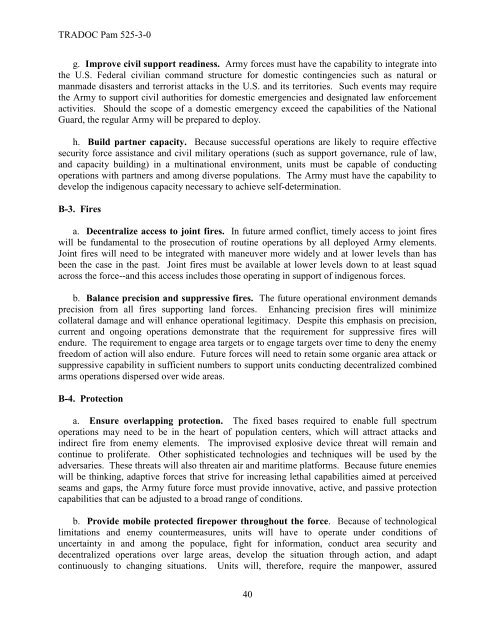(Pam) 525-3-0, The Army Capstone Concept - Federation of ...
(Pam) 525-3-0, The Army Capstone Concept - Federation of ...
(Pam) 525-3-0, The Army Capstone Concept - Federation of ...
Create successful ePaper yourself
Turn your PDF publications into a flip-book with our unique Google optimized e-Paper software.
TRADOC <strong>Pam</strong> <strong>525</strong>-3-0<br />
g. Improve civil support readiness. <strong>Army</strong> forces must have the capability to integrate into<br />
the U.S. Federal civilian command structure for domestic contingencies such as natural or<br />
manmade disasters and terrorist attacks in the U.S. and its territories. Such events may require<br />
the <strong>Army</strong> to support civil authorities for domestic emergencies and designated law enforcement<br />
activities. Should the scope <strong>of</strong> a domestic emergency exceed the capabilities <strong>of</strong> the National<br />
Guard, the regular <strong>Army</strong> will be prepared to deploy.<br />
h. Build partner capacity. Because successful operations are likely to require effective<br />
security force assistance and civil military operations (such as support governance, rule <strong>of</strong> law,<br />
and capacity building) in a multinational environment, units must be capable <strong>of</strong> conducting<br />
operations with partners and among diverse populations. <strong>The</strong> <strong>Army</strong> must have the capability to<br />
develop the indigenous capacity necessary to achieve self-determination.<br />
B-3. Fires<br />
a. Decentralize access to joint fires. In future armed conflict, timely access to joint fires<br />
will be fundamental to the prosecution <strong>of</strong> routine operations by all deployed <strong>Army</strong> elements.<br />
Joint fires will need to be integrated with maneuver more widely and at lower levels than has<br />
been the case in the past. Joint fires must be available at lower levels down to at least squad<br />
across the force--and this access includes those operating in support <strong>of</strong> indigenous forces.<br />
b. Balance precision and suppressive fires. <strong>The</strong> future operational environment demands<br />
precision from all fires supporting land forces. Enhancing precision fires will minimize<br />
collateral damage and will enhance operational legitimacy. Despite this emphasis on precision,<br />
current and ongoing operations demonstrate that the requirement for suppressive fires will<br />
endure. <strong>The</strong> requirement to engage area targets or to engage targets over time to deny the enemy<br />
freedom <strong>of</strong> action will also endure. Future forces will need to retain some organic area attack or<br />
suppressive capability in sufficient numbers to support units conducting decentralized combined<br />
arms operations dispersed over wide areas.<br />
B-4. Protection<br />
a. Ensure overlapping protection. <strong>The</strong> fixed bases required to enable full spectrum<br />
operations may need to be in the heart <strong>of</strong> population centers, which will attract attacks and<br />
indirect fire from enemy elements. <strong>The</strong> improvised explosive device threat will remain and<br />
continue to proliferate. Other sophisticated technologies and techniques will be used by the<br />
adversaries. <strong>The</strong>se threats will also threaten air and maritime platforms. Because future enemies<br />
will be thinking, adaptive forces that strive for increasing lethal capabilities aimed at perceived<br />
seams and gaps, the <strong>Army</strong> future force must provide innovative, active, and passive protection<br />
capabilities that can be adjusted to a broad range <strong>of</strong> conditions.<br />
b. Provide mobile protected firepower throughout the force. Because <strong>of</strong> technological<br />
limitations and enemy countermeasures, units will have to operate under conditions <strong>of</strong><br />
uncertainty in and among the populace, fight for information, conduct area security and<br />
decentralized operations over large areas, develop the situation through action, and adapt<br />
continuously to changing situations. Units will, therefore, require the manpower, assured<br />
40
















